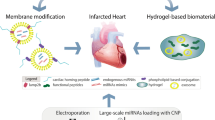Abstract
Despite recent advances in scientific knowledge and clinical practice, cardiovascular disease management and treatment remain a major burden. While several treatment strategies using drugs and surgeries are being developed for cardiovascular manifestations, gene-based therapies hold significant promise. Recent findings from our laboratory unveiled a novel mechanism that exosomes, secreted nanovesicles from stem cells, mediate cardiac repair via transferring their unique repertoire of microRNAs (miRNA) to recipient cells in the heart. Exosomes, unlike other vectors for gene delivery, present unique advantages such that exosomes are a cell-free natural system for ferrying RNA between cells, robust exosomal membrane can protect the RNA/gene of interest from digestion, and exosomes are rapidly taken up by target cells making them a more efficient vehicle for gene delivery. Here, we describe a stepwise protocol developed in our laboratory for generating exosomes from human CD34+ stem cells that carry exogenously applied Cy3 dye-labeled pre-miR miRNA precursors. We demonstrate that human CD34+ stem cell exosomes can rigorously enter into recipient cells and deliver Cy3 dye-labeled pre-miR miRNA precursors to regulate gene expression. Identification of key molecular targets to treat disease conditions is the foremost critical step and the novel approach presented here to generate exosomes carrying exogenous genetic information offers a valuable clinical tool for more effective treatment strategies.
Access this chapter
Tax calculation will be finalised at checkout
Purchases are for personal use only
Similar content being viewed by others
References
Pan BT, Johnstone RM (1983) Fate of the transferrin receptor during maturation of sheep reticulocytes in vitro: selective externalization of the receptor. Cell 33(3):967–978
Valadi H, Ekstrom K, Bossios A, Sjostrand M, Lee JJ, Lotvall JO (2007) Exosome-mediated transfer of mRNAs and microRNAs is a novel mechanism of genetic exchange between cells. Nat Cell Biol 9(6):654–659. doi:10.1038/ncb1596
Sahoo S, Losordo DW (2014) Exosomes and cardiac repair after myocardial infarction. Circ Res 114(2):333–344. doi:10.1161/CIRCRESAHA.114.300639
Thery C, Ostrowski M, Segura E (2009) Membrane vesicles as conveyors of immune responses. Nat Rev Immunol 9(8):581–593. doi:10.1038/nri2567
Parolini I, Federici C, Raggi C, Lugini L, Palleschi S, De Milito A, Coscia C, Iessi E, Logozzi M, Molinari A, Colone M, Tatti M, Sargiacomo M, Fais S (2009) Microenvironmental pH is a key factor for exosome traffic in tumor cells. J Biol Chem 284(49):34211–34222. doi:10.1074/jbc.M109.041152
Bartel DP (2004) MicroRNAs: genomics, biogenesis, mechanism, and function. Cell 116(2):281–297
Ambros V (2004) The functions of animal microRNAs. Nature 431(7006):350–355. doi:10.1038/nature02871
Liu N, Olson EN (2010) MicroRNA regulatory networks in cardiovascular development. Dev Cell 18(4):510–525. doi:10.1016/j.devcel.2010.03.010
Soifer HS, Rossi JJ, Saetrom P (2007) MicroRNAs in disease and potential therapeutic applications. Mol Ther 15(12):2070–2079. doi:10.1038/sj.mt.6300311
Olson EN (2014) MicroRNAs as therapeutic targets and biomarkers of cardiovascular disease. Sci Transl Med 6(239):239ps233. doi:10.1126/scitranslmed.3009008
van Rooij E, Purcell AL, Levin AA (2012) Developing microRNA therapeutics. Circ Res 110(3):496–507. doi:10.1161/CIRCRESAHA.111.247916
Mathiyalagan P, Okabe J, Chang L, Su Y, Du XJ, El-Osta A (2014) The primary microRNA-208b interacts with Polycomb-group protein, Ezh2, to regulate gene expression in the heart. Nucleic Acids Res 42(2):790–803. doi:10.1093/nar/gkt896
Hammoudi N, Ishikawa K, Hajjar RJ (2015) Adeno-associated virus-mediated gene therapy in cardiovascular disease. Curr Opin Cardiol 30(3):228–234. doi:10.1097/HCO.0000000000000159
Mittelbrunn M, Gutierrez-Vazquez C, Villarroya-Beltri C, Gonzalez S, Sanchez-CaboF, Gonzalez MA, Bernad A, Sanchez-Madrid F(2011) Unidirectional transfer of microRNA-loaded exosomes from T cells to antigen-presenting cells. Nat Commun 2:282. doi:10.1038/ncomms1285
Sahoo S, Klychko E, Thorne T, Misener S, Schultz KM, Millay M, Ito A, Liu T, Kamide C, Agrawal H, Perlman H, Qin G, Kishore R, Losordo DW (2011) Exosomes from human CD34(+) stem cells mediate their proangiogenic paracrine activity. Circ Res 109(7):724–728. doi:10.1161/CIRCRESAHA.111.253286
Zomer A, Maynard C, Verweij FJ, Kamermans A, Schafer R, Beerling E, Schiffelers RM, de Wit E, Berenguer J, Ellenbroek SI, Wurdinger T, Pegtel DM, van Rheenen J (2015) In Vivo imaging reveals extracellular vesicle-mediated phenocopying of metastatic behavior. Cell 161(5):1046–1057. doi:10.1016/j.cell.2015.04.042
Thery C, Amigorena S, Raposo G, Clayton A (2006) Isolation and characterization of exosomes from cell culture supernatants and biological fluids. Curr Protoc Cell Biol, Juan S Bonifacino, et al. (Eds.) Chapter 3:Unit 3 22. doi:10.1002/0471143030.cb0322s30
Acknowledgments
This work is supported by National Institute of Health R01- R01HL124187 (to SS) and American Heart Association-The Davee Foundation 12SDG12160052 (to SS).
Author information
Authors and Affiliations
Corresponding author
Editor information
Editors and Affiliations
Rights and permissions
Copyright information
© 2017 Springer Science+Business Media New York
About this protocol
Cite this protocol
Mathiyalagan, P., Sahoo, S. (2017). Exosomes-Based Gene Therapy for MicroRNA Delivery. In: Ishikawa, K. (eds) Cardiac Gene Therapy. Methods in Molecular Biology, vol 1521. Humana Press, New York, NY. https://doi.org/10.1007/978-1-4939-6588-5_9
Download citation
DOI: https://doi.org/10.1007/978-1-4939-6588-5_9
Published:
Publisher Name: Humana Press, New York, NY
Print ISBN: 978-1-4939-6586-1
Online ISBN: 978-1-4939-6588-5
eBook Packages: Springer Protocols




